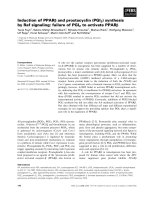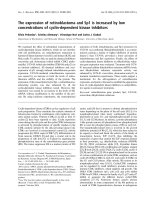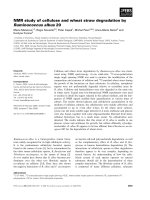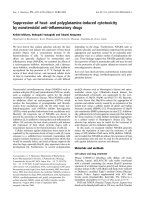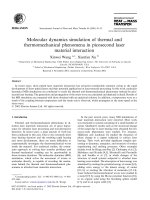Simulation of multiphase and multi component flows by lattice boltzmann method
Bạn đang xem bản rút gọn của tài liệu. Xem và tải ngay bản đầy đủ của tài liệu tại đây (2.55 MB, 253 trang )
Simulation of Multiphase and Multi-component
Flows by Lattice Boltzmann Method
Zheng Hongwei
(B. Sc., M. Sc.)
A THESIS SUBMITTED
FOR THE DEGREE OF DOCTOR OF PHILOSOPHY
DEPARTMENT OF MECHANICAL ENGINEERING
NATIONAL UNIVERSITY OF SINGAPORE
2007
To My Parents
i
Acknowledgements
I would like to express my sincere gratitude to my advisors, Professor Shu Chang and
Professor Chew Yong Tian, for their invaluable guidance and advice, and encouragement
throughout the course of this thesis. Besides, I also want to take this opportunity to acknowledge
and appreciate the National University of Singapore for the scholarship they have provided.
In addition, I would like to give my special thanks to my parents and wife whose patient
love and support enabled me to complete this work.
Zheng Hongwei
Table of Contents
ii
Table of Contents
Acknowledgements i
Table of Contents ii
Summary viii
List of Tables x
List of Figures xi
Nomenclature xv
Chapter 1 Introduction
1.1 Background 1
1.2 Overview of the lattice Boltzmann method 2
1.3 Literature review of multiphase flows modeling 6
1.3.1 Traditional CFD methods 6
1.3.2 Lattice Boltzmann methods 14
1.4 Contributions of the dissertation 22
1.5 Scope of the dissertation 24
1.6 Organization of the dissertation 25
Chapter 2 A General Platform for Developing a New Lattice Boltzmann Model
2.1 Introduction 28
Table of Contents
iii
2.2 General framework 29
2.3 Fluid dynamics 31
2.4 A general platform 35
2.5 Generation of single speed models from the platform 40
2.6 Generation of multi-speed models from the platform 42
2.7 Numerical verification 46
2.8 Conclusions 49
Chapter 3 Modeling Multiphase Flows by Lattice Boltzmann Method
3.1 Introduction 59
3.2 Rothman-Keller’s method 60
3.3 Shan and Chen’s method 62
3.4 Free Energy based method 65
3.4.1 Calculation of thermodynamic variables 66
3.4.2 The implementation by lattice Boltzmann method 69
3.4.3 Numerical simulation 72
3.5 Conclusion 74
Appendix. The calculation of the derivatives 76
Chapter 4 Lattice Boltzmann Interface Capturing Method for Incompressible
Multiphase Flows
4.1 Background 82
Table of Contents
iv
4.2 Methodology 85
4.2.1 Development of a new lattice Boltzmann interface capturing
model 85
4.2.2 Comparisons with other lattice Boltzmann interface capturing
models 90
4.3 Results and Discussion 93
4.3.1 Verification 93
4.3.2 Simple translation 95
4.3.3 Solid body rotation 96
4.3.4 Shear flow 98
4.3.5 Elongation field 101
4.4 Conclusion 103
Appendix A. Derivation of the new interface capturing method 105
Appendix B. Galilean invariance of interface capturing method 108
Chapter 5 Three-Dimensional Applications of the New Interface Capturing
Method
5.1 Background 118
5.2 Methodology 120
5.2.1 Cahn-Hilliard equation by lattice Boltzmann method 120
5.2.2 The direction split flux corrected transport (FCT)’s VOF 123
5.3 Results and discussion 125
Table of Contents
v
5.3.1 Verification 126
5.3.2 Solid body rotation 127
5.3.3 Elongation 130
5.3.4 Shear flow 133
5.5 Conclusion 135
Chapter 6 Lattice Boltzmann Model for Multiphase Flows with Large Density
Ratio
6.1 Introduction 144
6.2 Governing equations 147
6.2.1 The interface evolution equation 149
6.2.2 The momentum conservation equation 150
6.3. Implementation of lattice Boltzmann method 153
6.4. Numerical validation 156
6.4.1 A bubble in the stationary flow 156
6.4.2 Capillary wave 158
6.4.3 Bubble rising under buoyancy 160
6.5 Conclusion 163
Chapter 7 Three-Dimensional Applications of the New Lattice Boltzmann Model
for Multiphase Flows
7.1 Introduction 172
Table of Contents
vi
7.2 Implementation of lattice Boltzmann method 173
7.3 Numerical Validation 176
7.3.1 Inteface only problem under the vortex velocity field 176
7.3.2 A 3D bubble in the stationary flow 179
7.3.3 Capillary wave 180
7.3.4 Bubble rising under buoyancy 182
7.5 Conclusion 185
Chapter 8 Simulation of Non-sticking Multi-component Flows By LBM
8.1 Introduction 193
8.2 Method 195
8.2.1 Lattice Boltzmann method 195
8.2.2 Analysis 197
8.3 Numerical simulation 199
8.3.1 Verification 199
8.3.2 Two suspended components in static flow 200
8.3.3 Three suspension components under shear flow 202
8.4 Conclusion 203
Chapter 9 Conclusions
9.1 Conclusions 213
9.1.1 Development of a general platform for LBM 213
Table of Contents
vii
9.1.2 Development of a lattice Boltzmann interface capturing model 214
9.1.3 Development of a lattice Boltzmann model for multiphase flows with large
density ratio 216
9.1.4 Development of a lattice Boltzmann model for non-sticking multi-
component flows 217
9.2 Recommendations 218
References 220
Vita
viii
Summary
Numerical simulation of multiphase flows has drawn the attention by of many
researchers due to their many practical applications in both nature and industry. When
compared to the traditional computational fluid dynamics (CFD) solvers, lattice
Boltzmann method (LBM) has become a promising tool due to its simplicity, since it
only involves a series of collision and streaming processes. Consequently, with these
advantages, it is natural to apply it to model multiphase and multi-component flows.
In fact, the main aim of the thesis is to develop new lattice Boltzmann (LB) models
for these complex flows.
Since many theoretical derivations are involved in the LB modeling of these flows, a
general platform is developed to simplify the process. It serves as a general guide for
the researchers to develop their own LB models easily. The object of this platform is
to answer the two questions: one is that under which conditions, a discrete velocity
model can recover the Navier-Stokes equation and another question is how to
construct a velocity model which will satisfy these conditions. Based on the platform,
we can easily determine the equilibrium distribution functions for not only all the
published models but also the new LB models according to different applications.
The model of the multiphase and multi-component flows consists of interface
capturing and surface tension modeling. For the interface modeling, a new interface
capturing method is proposed to recover the Cahn Hilliard equation without additional
terms. It can also keep the Galilean invariance. In this model, the modified LB
equation (Lamura and Succi, 2002) is adopted to remove the time derivative related
term. In addition, it does not require fourth order tensor of the discrete velocity model
ix
to be isotropic. Thus, the D2Q5 discrete velocity model (D2 means two dimensional,
Q5 means five velocities) and the D3Q7 discrete velocity model can be used in two,
and three-dimensional applications, respectively. As a result, the computational
efficiency is greatly improved.
For the surface tension modeling, it employs a thermodynamically consistent form of
the surface tension term. There are two forms in modeling the surface tension term:
the potential form and stress form. Due to the different discretization error of these
two forms, we choose the potential form which is useful to eliminate parasite current
(Jamet et al., 2002). Based on the general platform and the choice of potential form, a
LB model for multiphase flows with large density ratio is developed. The two-
dimensional results agree well with numerical data of Takada et al. (2001). The three-
dimensional results agree well with the experimental findings of Clift et al. (1978) for
a real bubble rising under buoyancy with density ratio of 1000. Besides simulation of
multiphase flows, the non-sticking multi-component flows are also investigated.
In summary, four main parts are involved in this thesis. A general platform for
developing new LB models, a LB model for interface capturing, a LB model for
multi-phase flows with large density ratio and a LB model for non-sticking
multi-component flow were presented. The simulation of multiphase flows includes
modeling of the interface capturing and the surface tension term. This model recovers
the Chan-Hilliard equation without any additional terms and reduces the spurious
current by choosing the potential form of surface tension.
x
List of Tables
Table 2.1 Comparison of vortex centers by different lattice models (Re=1000) 50
Table 2.2 Comparison of primary vortex centers by different lattice models and
different Reynolds numbers 51
Table 3.1 Coexistence curve 78
Table 3.2 Verification of Laplace law 78
Table 6.1 The angular frequency of capillary wave 164
Table 6.2 Parameters for the simulation of a bubble rising under buoyancy 164
Table 6.3 Terminal velocity of a bubble rising under buoyancy 164
Table 7.1 The results for capillary wave 186
Table 7.2 The parameters for the simulation 186
Table 7.3 The terminal velocity of bubble 187
Table 8.1 The parameters for the simulation 205
xi
List of Figures
Figure 2.1 Configuration of D2S9 and D2S11 Models 52
Figure 2.2 Configuration of D2M13 and D2M17 Models 52
Figure 2.3 Normalized U velocity profile along central line 53
(a) Re = 400, (b) Re = 1000, (c) Re = 5000, (d) Re = 10000
Figure 2.4 Normalized V velocity profile along central line 54
(a) Re = 400, (b) Re = 1000, (c) Re = 5000, (d) Re = 10000
Figure 2.5 Streamlines obtained by D2M17 model for different Reynolds numbers
(a) Re = 400, (b) Re = 1000, (c) Re = 5000, (d) Re = 10000 55
Figure 2.6 Comparisons of normalized U profiles along center line for different
initial angles 56
Figure 2.7 Comparisons of normalized V profiles along center line for different
initial angles 58
Figure 3.1 The coexistence curve for different g 79
Figure 3.2 The geometry of D2Q9 79
Figure 3.3 The Interface profile 80
Figure 3.4 The coexistence curve 80
Figure 3.5 The verification of Laplace law81
Figure 4.1 The Coexistence curve 110
Figure 4.2 Verification of isotropy for
*
1
φ
=
110
Figure 4.3 Order parameter profile along the normal direction of the interface as a
function of the distance from the center of the disk 110
Figure 4.4 Initial Conditions 111
Figure 4.5 The results of simple translation by different methods 111
Figure 4.6 The results of the Hirt-Nichol’s VOF method (rotation case) 111
(a) T/4, (b) T/2, (c) 3T/4, (d) T
Figure 4.7 The results of the Level Set method (rotation case) 112
(a) T/4 (b) T/2, (c) 3 T /4, (d) T
xii
Figure 4.8 The results of present method (rotation case) 112
(a) T/4 (b) T/2, (c) 3 T /4, (d) T
Figure 4.9 Some disturbances generated by the method of Inamuro et al. (2004) 113
Figure 4.10 The results of the present method (Shear flow) 113
(a) T/4 (b) T/2, (c) 3 T /4, (d) T
Figure 4.11 The results of the Hirt-Nichol’s VOF method (Shear flow) 114
(a) T/4 (b) T/2, (c) 3 T /4, (d) T
Figure 4.12 The results of the Level Set method (Shear flow) 114
(a) T/4 (b) T/2, (c) 3 T /4, (d) T
Figure 4.13 Initial configuration (Elongation) 115
Figure 4.14 The result of the Hirt-Nichol’s VOF method (Elongation) 115
(a) t=0.5s (b)t=1s, (c) t=1.5s, (d) t=2s
Figure 4.15 The result of the Level Set method (Elongation) 116
(a) t=0.5s (b)t=1s, (c) t=1.5s, (d) t=2s
Figure 4.16 The result of the present method (Elongation) 117
(a) t=0.5s (b)t=1s, (c) t=1.5s, (d) t=2s
Figure 5.1 The interface profile 137
Figure 5.2 The initial configuration for the rotation case 137
Figure 5.3 The initial conditions 138
(a) Elongation (b) Shear Flow
Figure 5.4 The results of the direction split FCT VOF method (Rotation) 138
(a) t=0.5s (b)t=1s, (c) t=1.5s, (d) t=2s
Figure 5.5 The results of present method (Rotation) 139
(a) t=0.5s (b)t=1s, (c) t=1.5s, (d) t=2s
Figure 5.6 The results of the direction split FCT VOF method (Elongation) 140
(a) t=0.5s (b)t=1s, (c) t=1.5s, (d) t=2s
Figure 5.7 The results of present method (Elongation) 141
(a) t=0.5s (b)t=1s, (c) t=1.5s, (d) t=2s
Figure 5.8 The results of the direction split FCT VOF method (Shear Flow) 142
(a) t=0.5s (b)t=1s, (c) t=1.5s, (d) t=2s
Figure 5.9 The results of present method (Shear Flow) 143
(a) t=0.5s (b)t=1s, (c) t=1.5s, (d) t=2s
xiii
Figure 6.1 The influence of the width of the interface layer 165
Figure 6.2 The verification of Laplace law165
Figure 6.3 The interface profile 166
Figure 6.4 3D interface profile 166
Figure 6.5 Bubble shapes under different conditions 167
(a) case 1 (b) case 2 (c) case 3 (d) case 4
Figure 6.6 The flow pattern of a bubble rising under buoyancy with density ratio of
1000 ( 15.9840 , 0.6097, Re 3.2Eo M===) 168
Figure 6.7 The flow pattern of a bubble rising under buoyancy with density ratio of
1000 ( 39.96, 1.52425 ,Re 5.984Eo M== =) 169
Figure 6.8 The flow pattern of a bubble rising under buoyancy with density ratio of
1000 ( 79.92, 3.0485 ,Re 9.12Eo M== =) 170
Figure 6.9 The flow pattern of a bubble rising under buoyancy with density ratio of
1000 239.76, 9.146 ,Re 16Eo M===) 171
Figure 7.1 Initial configuration 187
Figure 7.2 The result of FCT VOF method188
a) t=0.5s b) t=1.0s c) t=1.5s d) t=2.0s
Figure 7.3 The result of present method 189
a) t=0.5s b) t=1.0s c) t=1.5s d) t=2.0s
Figure 7.4 The verification of Laplace law190
Figure 7.5 The initial configuration of capillary wave in three directions 190
Figure 7.6 Bubble rising with a spherical shape under low Reynolds number
(Re=0.4338) 191
Figure 7.7 Bubble rising with a dimpled shape under large Eo number (Eo=53.946)
192
Figure 8.1 The three forces acting at a position 205
Figure 8.2 Bifurcation (minimum density and maximum density vs. |g| ) 206
Figure 8.3 Results of Sticking Case (
,
0.08
jk
g
=
) 207
a) Step=100 b) Step=500 c) Step=2000 d) Step=10000
Figure 8.4 Results of sticking case (
,
0.10
jk
g
=
) 208
xiv
a) Step=100 b) Step=500 c) Step=1000 d) Step=6000
Figure 8.5 Results of non-sticking case (
,
0.13
jk
g
=
) 209
a) Step=100 b) Step=500 c) Step=5000 d) Step=10000
Figure 8.6 The critical value
*
,ab
g (vertical axis) versus
0,a
g (horizontal axis) 209
Figure 8.7 The initial configuration 210
Figure 8.8 Results of sticking case (
,
0.08
jk
g
=
) under shear flow 211
a) Step=200 b) Step=1000 c) Step=5000
Figure 8.9 Results of non-sticking case (
,
0.13
jk
g
=
) under shear flow 212
a) Step=1000 b) Step=5000 c) Step=8000
xv
Nomenclature
Latin Letters
a The initial amplitude
i
c Vector of the i-th lattice velocity
()
m
i
c Vector of the i-th lattice velocity in the m-th sublattice
iyix
cc , Cartesian components of the i-th lattice velocity
s
c Speed of sound
D (Spatial) Dimension
DnQm Lattice notation (n = dimension, m = number of particle velocities)
DnSm Single speed lattice notation (n = dimension, m = number of particle
velocities)
DnMm Multi-speed lattice notation (n = dimension, m = number of particle
velocities)
e
i
Vector of the i-th lattice velocity
Eo Eotvos number
F Body force
b
F
f
Body force
x
F ,
y
F The Cartesian components of the positive constant body force
i
f Density distribution function of the i-th particle
eq
i
f Equilibrium density distribution function of the i-th particle
()
m
i
f Distribution function of the i-th particle in the m-th sublattice
i, j, k The index of grid points in x, y, z direction, respectively
xvi
Kn Knudsen number
w
k Wave number
Mo Morton number
Ma Mach number
n Unit normal vector
NX, NY, NZ The number of grid points in x, y, z direction, respectively
O Order of magnitude
P Pressure tensor
p Local pressure
q Relaxation coefficient
Re Reynolds number
r Spatial vector
()
0
αβγ
S Third order momentum stress tensor
St Strouhal number
t Time step
phys
t Physical time
U Characteristic speed
u Velocity
u, v, w The Cartesian components of the velocity
W
The interface thickness
α
w Weights (Generalized lattice tensors)
x, y, z The Cartesian coordinates
Greek Letters
, Particle vectors
xvii
,xΔ yΔ , zΔ Spatial components of the distance of two mesh points
r
δ
Spatial step size
t
δ
Temporal step size
αβ
δ
Kronecker symbol
ℑ Free energy density
k The coefficient which is used to control the surface tension
Γ The coefficient which is used to control the mobility
ε
Expansion parameter
φ
The order parameter
H
φ
High order parameter
L
φ
Low order parameter
*
φ
Equilibrium state for order parameter
()
φ
ψ
Bulk free energy density
Collision term for interface capturing equation
ζ
The coordinate which is perpendicular to the interface
φ
μ
Chemical potential
Π Second order momentum stress tensor
M
θ
Mobility
ω
The oscillation frequency
Fluid density
H
ρ
High density
L
ρ
Low density
λ
The ratio of dimaeter
xviii
∑
Summation
σ
Surface tension
γ
The ratio of viscosity
τ
Relaxation parameter
υ
Kinetic viscosity
Collision operator
Miscellaneous Symbols
∇ Nabla operator
Δ Increment
∂ Partial derivative
Abbreviations
BGK Bhatnagar-Gross-Krook
CFD Computational fluid dynamics
DSFCT Direction split flux corrected transport
DV Discrete velocity
FCT Flux corrected transport
FLAIR Flux Line-segment model for Advection and Interface Reconstruction
LBE Lattice Boltzmann equation
LBM Lattice Boltzmann method
LGCA Lattice gas cellular automata
LSM Level set method
N-S Navier-Stokes
ODEs Ordinary differential equations
xix
TLLBM Taylor-series-expansion- and Least-square-based lattice Boltzmann
method
VOF Volume of fluid method
Chapter 1 Introduction
1
Chapter 1 Introduction
1.1 Background
Since the fluid is ubiquitous in the world, fluid dynamics has wide applications in
many areas of industry. Among these areas, the dynamics of multiphase flow has
drawn many attentions from the scientists for a long time. The term multiphase flow
here is used to refer to any fluid flow consisting of more than one phase or component.
The dynamics of multiphase flows has many practical applications in engineering,
such as oil-water flow in porous media, boiling fluids, liquid metal melting and
solidification. Because of the complexity of these problems, it is often necessary to
utilize computational (or numerical) methods to solve the complex equations that
describe them. In fact, there are many computational methods developed in both the
traditional computational fluid dynamics (CFD) and the lattice Boltzmann method
(LBM). Among them, LBM has become a promising tool since 1980s due to its
simplicity. It is very simple in the sense that it only involves a series of iterative steps
which consist of the collision and the stream step. The collision step is a local
operation which is conductive to parallel computing. Besides, unlike the traditional
computational fluid dynamics (CFD), it does not solve the non-linear partial
differential equation (PDE). Furthermore, the pressure is calculated from the state
equation instead of solving the Poisson equation in CFD. For these reasons, it has
become a promising solver for incompressible flows with low Reynolds numbers.
Chapter 1 Introduction
2
Consequently, with these advantages, it is natural to apply it to model multiphase
flows.
1.2 Overview of lattice Boltzmann method
To understand the lattice Boltzmann method, it is necessary for us to review some
basic aspects of LBM first. In history, the lattice Boltzmann method comes from
Lattice Gas cellular automata (LGCA) which is firstly proposed by Hardy, Pomeau
and de Pazzis (1973). The particle of LGCA is considered as a virtual particle which
consists of many real molecules. These particles have the same mass and are
in-distinguishable. They propagate under a certain discrete velocity (DV) model. They
exchange momentum while conserving the mass and momentum at each site. Besides,
each site should obey the exclusion principle that it may be empty or occupied by at
most one particle in every site. This Boolean feature will lead to Fermi-Dirac type of
equilibrium distributions (Wolf-Gladrow, 2000).
The algorithm of LGCA can be divided into advection (or propagation or stream) step
and collision step. During the advection step, the virtual particles propagate to the
nearest-neighboring sites with the constraint of the DV model. This can be
implemented simply by using the CShift procedure (under Visual Fortran or Visual
C++ environment). In contrast, the collision step is completely local. The collision
step is the most time-consuming because it is related to the recalculation of the
Chapter 1 Introduction
3
distribution function. Due to the locality and time consuming feature of the collision
step, the computing requires nearly no communications. Hence, LGCA is very
suitable to parallel computing because it can produce high computation to
communication ratio.
Despite of these good features, there are two main shortcomings of the LGCA. One
major drawback of the method is the statistical noise in the computed hydrodynamic
fields. This shortcoming is a direct consequence of the single particle Boolean
dynamics. To obtain accurate results for the hydro-dynamical fields, averaging over a
large number of time steps and/or lattice points are often required and therefore the
simulations may be rather inefficient.
The second drawback is the lack of Galilean invariance. In the area of hydrodynamics,
it should also be consistent with the Navier-Stokes equation. The Navier-Stokes
equation has the feature that it is invariant when the frame is transformed to a
different inertial frame under the Galilean rule. Galilean invariance requires the
coefficient of the nonlinear advection term to be one. It can be easily found that the
momentum flux tensor in the first order is related to the advection term. This
momentum flux tensor is defined as
()
()
⎥
⎥
⎦
⎤
⎢
⎢
⎣
⎡
⎟
⎟
⎠
⎞
⎜
⎜
⎝
⎛
−+==Π
∑
αββαβααβ
δ
δ
ρρ
2
2
20
1
x
s
i
ii
eq
i
u
gcuguccf ,
with
Chapter 1 Introduction
4
()
d
d
D
D
g
−
−
+
=
1
21
2
ρ
,
where D is the dimension and the reduced fluid density d reads
b
d
ρ
=
.
Here, b is the number of discrete velocities.
The first term of the momentum flux tensor is responsible for the advection term
uu
ff
∇ in the Navier-Stokes equation; the second term is associated with fluid pressure.
To make advection Galilean invariant we need g to be equal to one as stated before.
The pressure term is also weird because it consists of a velocity dependent term. This
is different from the density dependent pressure term in the Navier-Stokes equation.
Besides, if you write out the momentum flux tensor in the second order, you will find
that the viscosity is also a function of density. These lead to the lack of Galilean
invariance.
To remove these drawbacks of the LGCA, the lattice Boltzmann method is proposed.
The Boolean variables and the Fermi-Dirac equilibrium distribution function in
LGCA are replaced by real type variables which are ensemble averaged quantity and
Maxwell equilibrium distribution function in LBM. Then, the statistical noise is
reduced and the Galilean invariance is recovered in the incompressible limit.
Furthermore, the collision operator was replaced by the single relaxation time
approximation, introduced initially by Bhatnagar, Gross, and Krook (BGK, 1954).
The collision and stream steps are kept in LBM. Thus, LBM inherits the simplicity


